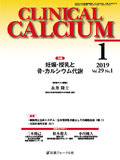Japanese
English
- 有料閲覧
- Abstract 文献概要
- 1ページ目 Look Inside
- 参考文献 Reference
妊娠後骨粗鬆症(post-pregnancy osteoporosis)は,原因が不明な稀な病態で,初産婦に多く,妊娠後期や産褥の授乳中に発症し,非外傷性の脆弱性脊椎骨折による持続する激しい痛みと行動制限を伴うことが多い。椎体X線像は多くの骨折の診断に使用されるが,magnetic resonanceは妊娠中も安全に使用可能で椎体骨折や骨髄浮腫の診断にも有用である。その診断には続発性骨粗鬆症(内分泌疾患,悪性腫瘍,慢性肝・腎疾患,自己免疫疾患,遺伝性疾患,薬剤性,悪性腫瘍など)の鑑別が重要である。妊娠後骨粗鬆症の頻度は不明であるが,1万人の妊婦のうち3人以上が発症しているかもしれない。その病態も不明であり,妊娠授乳期の生理的な骨吸収では一般的には骨折を起こさないため,骨折を起こした女性には,低体重,低peak bone mass,低栄養,遺伝など,さらなる2次的な要因があるかもしれない。
Post-pregnancy osteoporosis is a rare condition with little known pathophysiology. Most cases are diagnosed in the late stage of pregnancy or in the post partum while breastfeeding, particularly in first pregnancy. Non-traumatic vertebral fragility fractures are most commonly observed and characterized by prolonged severe pain and functional limitations. Conventional radiography will confirm the fracture in most cases, and magnetic resonance, which can be safely used during pregnancy, is effective in detecting vertebral fractures and bone marrow edema. It is important to exclude secondary osteoporosis, e.g. endocrine diseases, chronic liver and kidney diseases, autoimmune diseases, genetic diseases, drugs and malignant tumors. The prevalence of post-pregnancy osteoporosis is unknown, and may be estimated more than 3 for every ten thousand pregnant women. The pathophysiology of post-pregnancy osteoporosis is also unknown. The physiological bone resorption during reproduction does not normally cause fracture;instead, women who do fracture may be more likely to have additional secondary causes of bone loss and fragility, e.g. low body weight, low peak bone mass, malnutrition and heredity.



